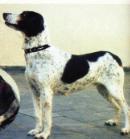
This is a placeholder text
Group text
by jdrenski on 23 September 2006 - 00:09
you should strongly consider killing that dog and moving forward. Please don't breed her. It is very difficult to find a dog without inbreeding/linebreeding and when you do, you may find less health problems with the line!
by Bob-O on 23 September 2006 - 00:09
Redcap, the stifles can also be an issue if the length ratio, angle, and motion range is not correct as it relates to the hock and finally the femur. I am glad that you brought that up since it is usually overlooked as the hock is much more visible.
While I can prove nothing, it seems that during a conformation critique of the rear leg assembly that much more attention is paid to the relationship of the stifle with the foot rather than the hock while the dog is in a natural stand. Too short & vertical=much abuse to the leg assembly while in hard motion. Too long and horizontal=too much lost force while in hard motion.
If anyone wants to expand on this subject, please do. The foot-stifle-hock relationship is to my limited knowledge something that we have never discussed.
Bob-O
by redcap on 23 September 2006 - 00:09
Would someone PLEASE put 'jdrenski' out of his misery!!! Any doctors aboard, he desperately needs a serotonin reuptake inhibitor.
by redcap on 23 September 2006 - 00:09
Thanks Bob-O, I look forward to seeing some further enlightening discussion of this subject as I have always been a bit confused about the ideal relationship of the 'rear assembly' and its relationship to movement and soundness.
by jdrenski on 23 September 2006 - 01:09
I hope you f%$@##s die.
by Bob-O on 23 September 2006 - 01:09
Redcap, I quickly made a CADD model of a lower leg assembly (by viewing a picture of a GSD skeleton), added some geometric variants, and made a quick static stress analysis of each example.
Just as I suspected, a stifle that is just a tiny bit long and horizontal forces the hock to become more horizontal as well in order to preserve the joint integrity. This would of course require the ligaments to stretch a bit in order to accomodate the additional stress placed on the hock where it meets the stifle, and force an angulation change between the hock and the femur.
In the real world this would be incredibly difficult to measure, let alone calculate. I think we only see a problem when it approaches such a vertical or horizontal position that it becomes very obvious to the observer.
Please, if anyone else can expand this subject, do so.
Bob-O
by jdrenski on 23 September 2006 - 01:09
You are an idiot and I hope no one listens to you. Please kill yourself.
by redcap on 23 September 2006 - 02:09
"a stifle that is just a tiny bit long and horizontal forces the hock to become more horizontal as well..." Creating sickle hocks?
by Maverick13 on 23 September 2006 - 18:09
Bob O you suggested swimming to help the cow hocks and i was just wondering just how long a puppy or a dog should be made to swim and how often. Thanks
by jdh on 23 September 2006 - 19:09
This is possibly related to a disproportionately long stifle, however strength and elasticity of tendon are critical issues. The statement that the American Shepherds have very loose rear assemblies is quite correct. It is painful to watch them move and know that they share ancestors with the best movers in the world. SV judges pay special attention to all parts of a dogs construction and movement and any looseness is strongly criticized as exemplary tightness of ligaments is praised.
Contact information Disclaimer Privacy Statement Copyright Information Terms of Service Cookie policy ↑ Back to top





